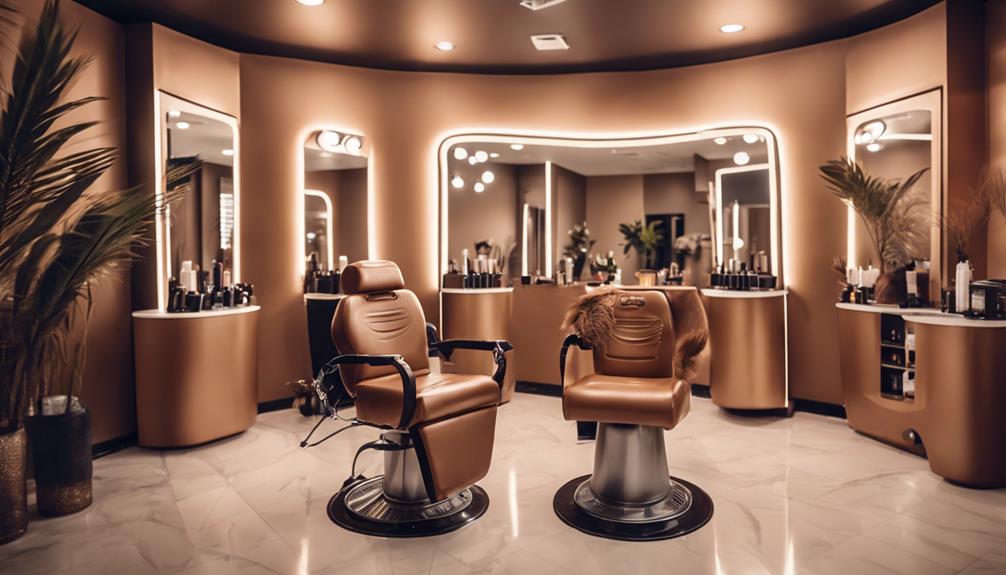You can absolutely glow with a tan while keeping acne in check! First, know your skin type—this'll help you pick the right tanning products. Go for non-comedogenic options, which won't clog your pores. Ditch the tanning beds and try sunless tanners or professional spray tans for a safer glow. Before you tan, exfoliate gently so your skin's smooth, and always hydrate to boost your results. When applying, use a tanning mitt to avoid streaking, and take your time blending for a natural look. Want to uncover more tips for your best tan yet? Just stick around!
Key Takeaways
- Identify your skin type to choose suitable tanning products that won't exacerbate acne.
- Use non-comedogenic self-tanners, ideally oil-free, to prevent pore clogging.
- Conduct a patch test on a small area to check for adverse reactions before applying tanner.
- Exfoliate gently before tanning to create a smooth surface and enhance product absorption.
Understand Your Skin Type
How well do you know your skin type, and how does it affect your tanning choices?
If you've got oily skin, you might wanna be careful with heavy products.
Dry skin? You'll need to hydrate before you glow!
Combo skin? Well, that's like having a party—just make sure everyone gets along.
Sensitive skin can be tricky; it's like a drama queen that reacts to everything!
Knowing your type helps you pick the right products and avoid those pesky breakouts.
Plus, exfoliating before you tan is essential—it's like prepping your canvas!
So, take a moment to figure it out.
Your skin deserves the best, and a little knowledge goes a long way in getting that perfect sun-kissed look without the hassle!
Choose Non-Comedogenic Products

Knowing your skin type sets the stage for choosing non-comedogenic products that won't clog your pores or trigger breakouts.
If you've got acne-prone skin, skip the heavy lotions and grab oil-free sunless tanners instead. Look for products with DHA; they'll give you that sun-kissed glow without the nasty side effects.
And hey, don't use body tanners on your face—your pores will thank you later! Always check labels for sneaky comedogenic ingredients hiding in plain sight.
If you're unsure, a quick chat with a dermatologist can work wonders. Remember, prepping your skin with separate cleansers and moisturizers can make a huge difference too.
Embrace your glow without the breakouts; your skin deserves it!
Alternatives to Tanning Beds

Exploring sunless tanning options is a smart way to achieve a glowing complexion without the risks associated with tanning beds. Have you tried self-tanners? They can give you that sun-kissed look without frying your skin!
You can use lotions, sprays, or even those cute tanning towelettes. Just remember to choose non-comedogenic products to keep your skin happy and acne-free.
If you're feeling fancy, you could visit a salon for a professional spray tan, which usually looks awesome! Plus, you won't have to worry about streaks.
Pre-Tanning Skin Preparation

Before you start tanning, it's important to prepare your skin properly to guarantee a smooth and even application.
First things first, you've got to know your skin type—are you oily, dry, or somewhere in between? This helps you pick the right products.
Next, exfoliate gently to buff away dead skin cells. Think of it as giving your skin a fresh start!
And remember, non-comedogenic products are your best friends; they won't clog your pores or aggravate acne.
It's also smart to do a patch test, especially with bronzers. You wouldn't want surprise orange spots, right?
So, hydrate your skin too—it's like watering a plant before it gets sunny!
Now, you're all set for that perfect glow!
Safe Application Techniques

Using the right application techniques can make all the difference in achieving a flawless tan while keeping your acne-prone skin safe.
First things first, always start with clean, exfoliated skin—think of it as prepping your canvas!
Use a tanning mitt to avoid streaks and protect your hands.
When applying, go slowly, and don't forget those tricky spots like your elbows and knees.
Remember to blend, blend, blend!
If you're nervous, try a patch test on a small area to avoid any surprises.
And hey, don't rush—let each layer dry before adding more.
You want that sun-kissed glow, not a patchy disaster!
Trust me, a little patience goes a long way toward achieving that perfect tan without aggravating your skin.
Frequently Asked Questions
Can I Use Self-Tanner on Active Acne Spots?
You shouldn't use self-tanner on active acne spots, as it can clog pores and worsen breakouts. Instead, focus on treating your acne first, then apply self-tanner once your skin is clearer and healthier.
How Long Does Self-Tanner Usually Last on the Skin?
Self-tanner's like magic; it can transform your skin! Typically, it lasts about five to seven days, depending on your skin type and care routine. Exfoliation and moisturizing can help maintain that sun-kissed glow longer.
Will Self-Tanner Make My Acne Worse Over Time?
Self-tanner won't necessarily make your acne worse over time, but choosing non-comedogenic products is essential. Always patch test new products and exfoliate before application to guarantee your skin stays clear and healthy.
Can I Mix Self-Tanner With My Moisturizer?
You can mix self-tanner with your moisturizer to achieve a subtle glow. Just make certain the self-tanner is non-comedogenic. Test the mixture on a small area first to avoid any unexpected reactions or streaks.
What Should I Do if I Experience a Reaction to Self-Tanner?
If you experience a reaction to self-tanner, stop using it immediately. Rinse your skin with cool water, apply a soothing moisturizer, and consider consulting a dermatologist for further advice and treatment options.
Conclusion
So, ready to rock that sun-kissed glow without the breakouts?
Remember, taking care of your acne-prone skin doesn't have to be a hassle. Just choose the right products, prep your skin well, and apply like a pro!
After all, who wouldn't want a gorgeous tan without the worry of a breakout?
With these tips, you can confidently flaunt your radiant skin and maybe even add a little sparkle to your day!
You've got this!










